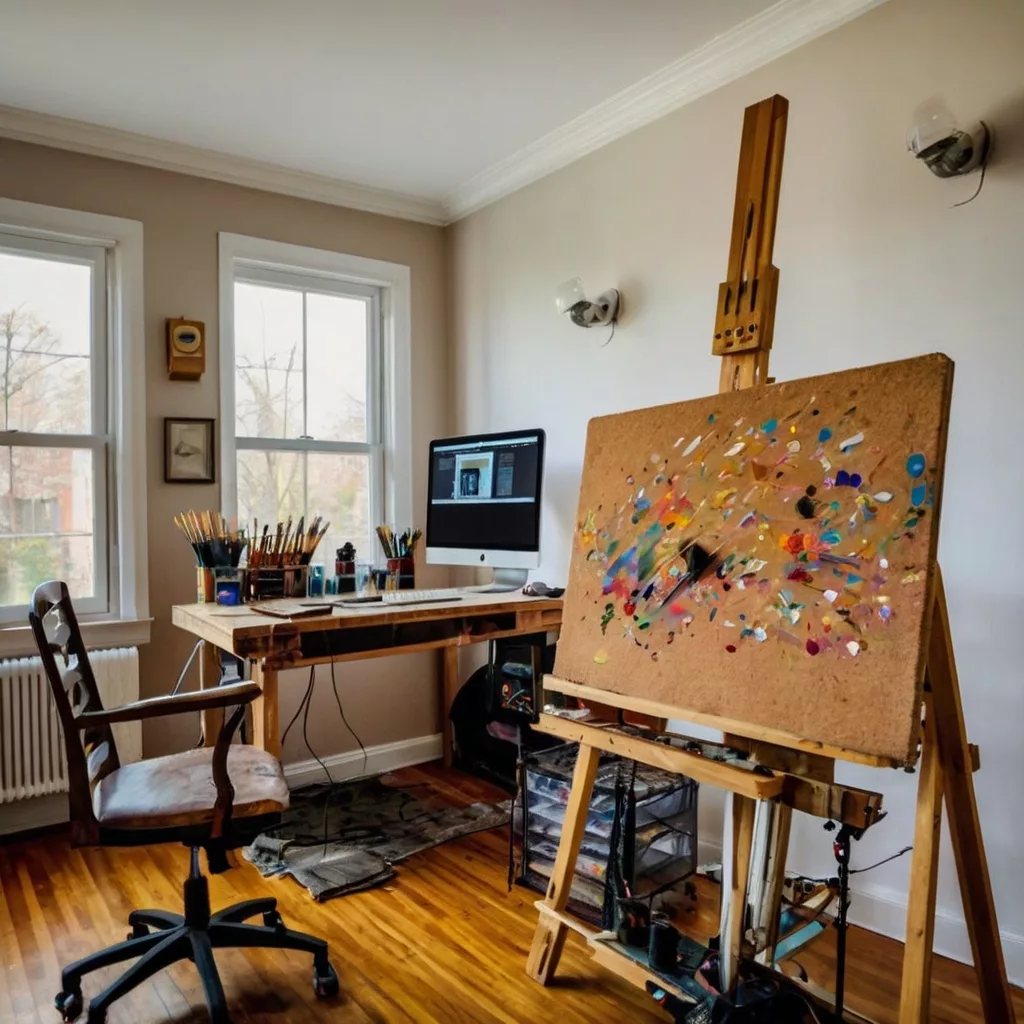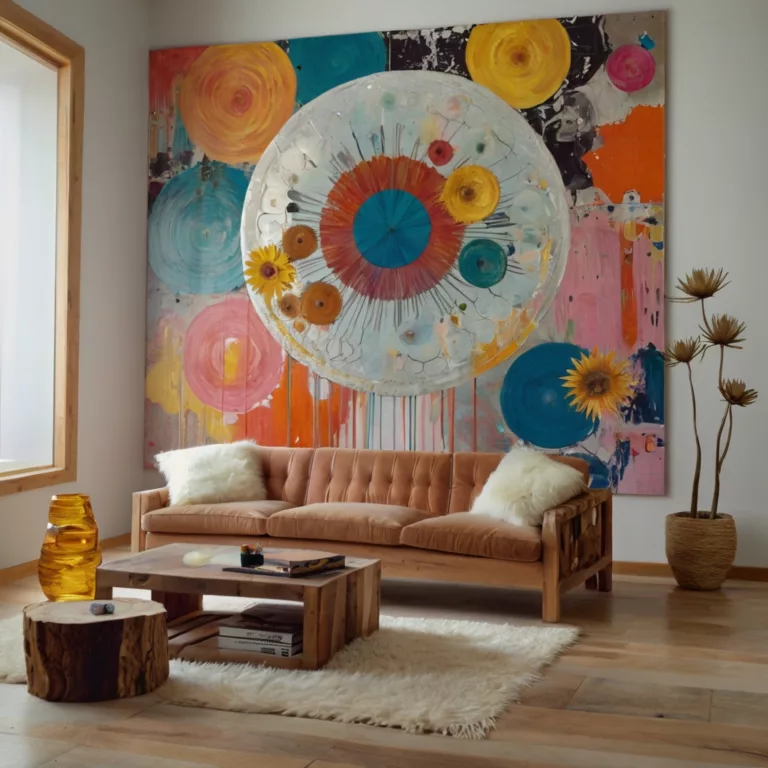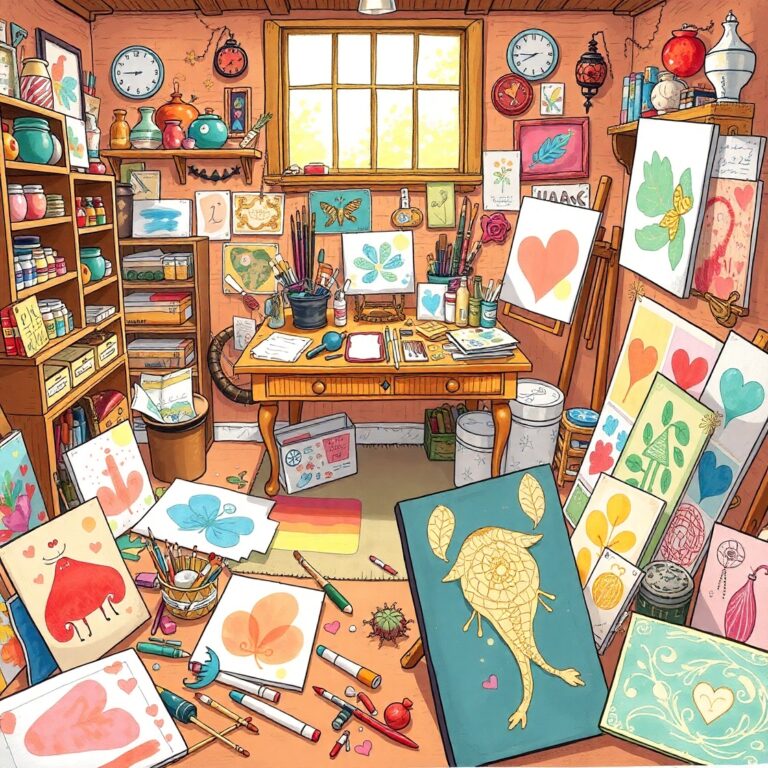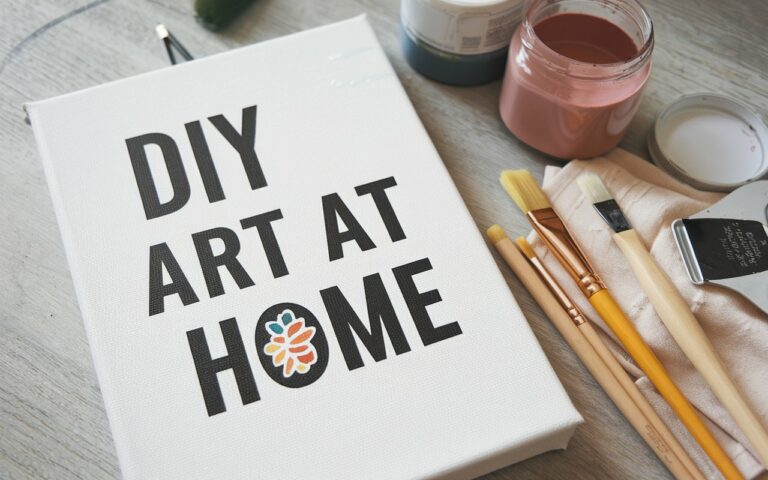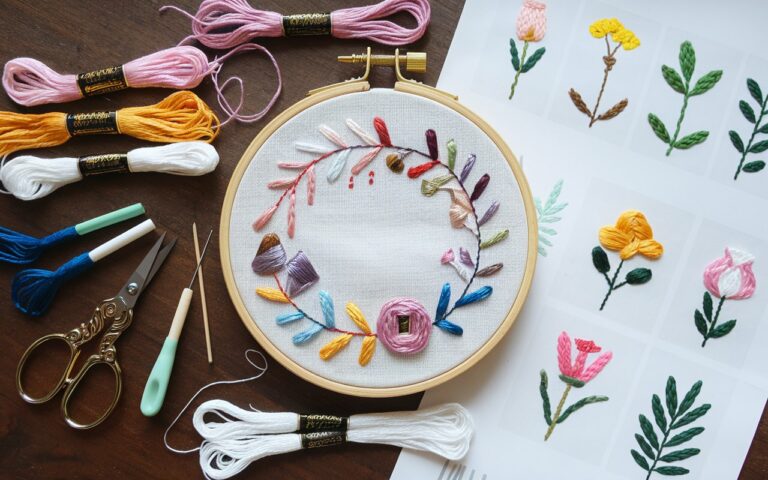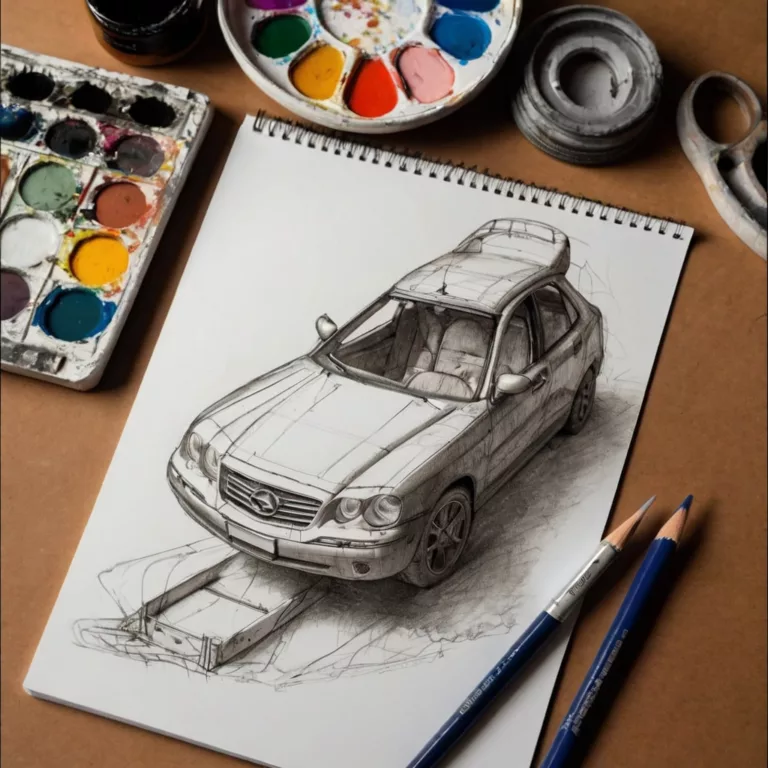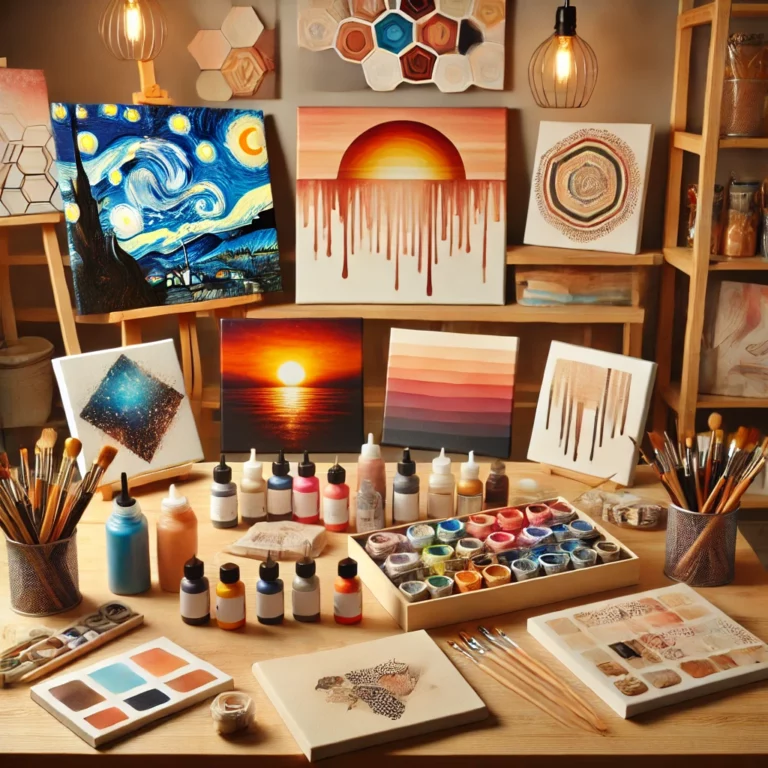Creating Your Ultimate Home Art Studio: The Complete Guide
Transforming Space into Creative Possibility
The concept of the artist’s studio has evolved dramatically throughout history from the grand ateliers of Renaissance masters to the modest garrets of Parisian bohemians to today’s versatile home studios. In our contemporary world, where digital connectivity allows creative professionals to work from anywhere, the home art studio has become more relevant than ever. More than simply a physical space, a well-designed home studio becomes an extension of the artist’s mind a sanctuary where creativity flows unimpeded and technical abilities can be honed to perfection.
This comprehensive guide will take you beyond the basics of setting up a home art studio, delving into the nuanced considerations that transform a mere room into a personalized creative powerhouse. Whether you’re a professional artist seeking to optimize your workspace, a passionate hobbyist looking to elevate your practice, or someone rediscovering artistic pursuits after years away, this guide offers insights for creating a studio that nurtures your particular creative vision.
The beauty of the home art studio lies in its intimate connection to your life and artistic identity. Unlike commercial spaces, a home studio can be tailored precisely to your creative process, aesthetic preferences, and practical needs. It evolves with you, adapting to new directions in your work and changes in your life circumstances. By thoughtfully designing this space, you create not just a workshop but a creative ecosystem that supports every aspect of your artistic journey.
In the pages that follow, we’ll explore everything from spatial planning and ergonomics to lighting solutions and specialized equipment. We’ll consider how different artistic disciplines require different studio configurations and how to maximize even the most challenging spaces. Most importantly, we’ll examine how to create a studio that inspires you daily, making the act of entering your creative space a catalyst for imaginative thinking and productive work.
Finding Your Space: Creative Solutions for Every Home
Assessing Your Spatial Possibilities
The first step in creating your home art studio involves taking inventory of available space with fresh eyes. While a dedicated room represents the ideal scenario, creative studio solutions can be implemented in surprisingly compact areas:
Dedicated Rooms and Their Potential:
- Spare bedrooms offer ready-made privacy and often include closets for storage
- Finished basements provide isolation and temperature stability, though lighting needs special attention
- Attics offer character and interesting architectural features but require climate control consideration
- Garages provide ample space and durability but need insulation and proper electrical upgrades
Alternative Spaces When Room is Limited:
- Room dividers and screens can section off a studio corner in shared living areas
- Convertible solutions such as murphy beds or fold-down desks create temporary studio space
- Underutilized spaces like landings, hallway nooks, or alcoves can become compact work areas
- Outdoor options including garden studios, converted sheds, or weatherproof balcony setups
Evaluating Space Beyond Square Footage:
- Natural light availability and direction
- Ceiling height for accommodating easels, large canvases, or hanging works
- Floor durability and appropriate covering options
- Sound considerations, especially for shared housing
- Accessibility factors for comfortable daily use
Spatial Planning for Creative Flow
The arrangement of your studio profoundly impacts your creative practice, influencing everything from physical comfort to mental focus. Consider these principles when planning your space:
Work Zones Based on Artistic Process:
- Primary creation zone with your main workstation (easel, desk, drafting table)
- Wet media area with water access and durable surfaces
- Dry media zone for drawing, planning, and detail work
- Digital creation station if computer work is part of your practice
- Documentation space for photographing completed works
- Reflection area where work can be viewed from distance
Flow Planning Considerations:
- Create intuitive transitions between different work stages
- Ensure adequate clearance around workstations (minimum 3 feet recommended)
- Consider the natural sequence of your creative process
- Plan for both standing and sitting work positions
- Accommodate sufficient rear distance for perspective viewing
Space-Maximizing Strategies:
- Vertical storage utilizing wall height effectively
- Modular furniture that adapts to different projects
- Mobile workstations and storage on wheels for flexibility
- Multi-purpose surfaces that transform for different techniques
- Strategic use of corners and typically underutilized spaces
The Foundation: Floors, Walls, and Infrastructure
Floor Solutions for Different Media
The foundation of your studio deserves careful consideration, as the right flooring can make maintenance easier and protect your investment in the space:
Options for Various Artistic Practices:
- Sealed concrete for durability in high-traffic studios with wet media
- Hardwood with polyurethane coating for warm aesthetics with protection
- Luxury vinyl plank (LVP) offering waterproof durability with design options
- Cork for comfort during long standing sessions and dropped tool cushioning
- Interlocking foam tiles for ergonomic standing areas at primary workstations
Protective Strategies for Existing Floors:
- Commercial-grade drop cloths with leak-proof backing
- Washable area rugs designated for studio use
- Splatter mats designed for art studios with non-slip backing
- Rolling chair mats extended beyond normal size for art studio movement
- Floor finishing techniques that embrace artistic “accidents” as design features
Wall Preparation and Utilization
Walls in an art studio serve multiple crucial functions beyond mere boundaries:
Surface Treatments for Studio Walls:
- Semi-gloss or satin finish paint for easy cleaning and light reflection
- Magnetic primer under topcoat for flexible display options
- Cork or bulletin board sections for evolving inspiration and planning
- Slat wall systems or pegboard for adjustable storage
- Marker board paint for large-scale ideation and project planning
Strategic Wall Organization:
- Color-coded zones for different supplies or project stages
- Adjustable shelving with standardized spacing for future flexibility
- Grid systems for modular organization that grows with your practice
- Vertical file storage for works on paper and reference materials
- Dedicated inspiration wall that changes with current projects
Essential Infrastructure Upgrades
Before arranging furniture and equipment, consider these fundamental infrastructure elements:
Electrical Considerations:
- Additional outlets placed strategically at workstations (minimum 4-6 per station)
- Dedicated circuits for high-draw equipment like kilns, heaters, or power tools
- Properly grounded outlets for all electronics and digital equipment
- Track lighting systems on separate switches for zone control
- Surge protectors and cord management solutions for safety
Plumbing Adaptations:
- Utility sink installation options (free-standing, wall-mounted, or converted cabinet)
- Portable water stations if permanent plumbing isn’t possible
- Gray water collection systems for environmentally conscious studios
- Specialized disposal systems for art chemicals where required
- Counter protection for temporary water stations in multi-purpose spaces
Climate and Ventilation Requirements:
- Appropriate ventilation for media with fumes or particulates
- Humidity control for paper storage and mixed media preservation
- Air purification systems for health maintenance
- Temperature regulation for comfort and material stability
- Seasonal adjustments for changing environmental conditions
Illuminating Creativity: Studio Lighting Solutions
The Art of Lighting for Artists
Lighting represents perhaps the most critical element of studio design, directly impacting both the creation and perception of your work:
Natural Light Management:
- North-facing windows (northern hemisphere) for consistent, shadow-free light
- Light diffusion solutions for direct sunlight (sheer curtains, translucent blinds)
- Reflector placement to maximize natural light distribution
- Seasonal adjustments for changing sun angles
- Window treatments that offer variable light control
Artificial Lighting Systems:
- Full-spectrum lighting that approximates natural daylight (5000-6500K color temperature)
- Color Rendering Index (CRI) considerations (90+ recommended for accurate color work)
- Layered lighting approach combining ambient, task, and accent lighting
- Adjustable options including dimming, directional change, and color temperature
- Energy-efficient LED systems that reduce heat generation
Specialized Lighting Setups:
- Articulating arm lamps with magnification for detail work
- Overhead track systems with adjustable heads for flexible coverage
- Light boxes for tracing and transparency work
- Photography lighting kits for documentation
- Dramatic lighting options for creating specific effects and test viewing
Practical Lighting Solutions for Every Budget
Creating ideal studio lighting doesn’t necessarily require professional installation or high expense:
Budget-Friendly Professional Lighting:
- Clamp lights with daylight balanced bulbs
- DIY light diffusion using white shower curtains or ripstop nylon
- Repurposed photography umbrella reflectors
- Strategic mirror placement to amplify existing light
- Smart bulbs that adjust color temperature via smartphone control
Lighting Placement Strategies:
- Primary light source positioned to avoid hand shadows
- Secondary fill light eliminating problematic shadows
- Background lighting to reduce eye strain from contrast
- Accent lighting highlighting reference materials or work in progress
- Adaptable positioning for different times of day and projects
Furnishing for Function: Studio Furniture and Equipment
Core Workstations for Different Disciplines
The heart of any studio is its primary work surface, which should be tailored to your specific artistic practice:
Painting and Drawing Setups:
- Easel considerations: studio vs. field, H-frame vs. A-frame, floor vs. tabletop
- Drawing table options with adjustable angle and height
- Ergonomic considerations for long working sessions
- Surface area requirements for different scales of work
- Auxiliary surfaces for pallette preparation and tool layout
Sculpture and 3D Work Stations:
- Sturdy tables with appropriate weight capacity
- Surrounding clearance for all-angle access
- Surface durability for tools and material impact
- Height considerations for standing work
- Specialized surfaces like modeling boards or clay tables
Mixed Media and Craft Studios:
- Heat-resistant surfaces for hot tools
- Cut-proof areas for exacto and blade work
- Clean assembly zones separated from messier processes
- Varying heights for different tasks within projects
- Integrated storage for multi-step projects
Digital Creation Stations:
- Ergonomic seating for extended computer sessions
- Monitor positioning at eye level
- Tablet integration with appropriate angle
- Cable management solutions
- Transition areas between digital and traditional work
Storage Solutions: Organizing Creative Materials
Effective storage transforms studio functionality, making the creative process seamless rather than a constant search for supplies:
Visible vs. Concealed Storage Strategy:
- Transparent storage for frequently used items and color inspiration
- Concealed options for visual clutter reduction
- Combination systems that organize by usage frequency
- Psychological benefits of different storage approaches
- Aesthetic integration with overall studio design
Customizable Systems for Evolving Needs:
- Modular components that reconfigure as your practice changes
- Standardized containers for visual cohesion and stacking efficiency
- Labeling systems that make sense for your workflow
- Mobile storage that relocates based on current projects
- Adaptable solutions that grow with material acquisition
Specialized Artist Storage Solutions:
- Flat files for works on paper and prints
- Vertical storage for canvases and panels
- Brush organization systems that protect bristles
- Small-item organization for beads, findings, and detail elements
- Hazardous material storage meeting safety requirements
Ergonomics: Creating Physical Comfort for Creative Longevity
Artists often work for extended periods in positions that can strain the body without proper ergonomic consideration:
Seating and Standing Considerations:
- Professional artist stools with appropriate height range
- Ergonomic chairs for detailed or computer work
- Anti-fatigue mats for standing easel or sculpture work
- Footrests and supports for proper posture
- Movement encouragement through varied work positions
Preventing Studio-Related Injuries:
- Proper tool handling positions and support
- Wrist guards and supports for repetitive tasks
- Reaching zone organization to prevent strain
- Lighting positioning to prevent neck strain from shadows
- Scheduled breaks and movement protocols
Creating Atmosphere: The Psychology of Studio Design
Color Psychology and Studio Environments
The colors surrounding you influence mood, energy, and even perception of your own work:
Strategic Color Selection:
- Neutral backgrounds for accurate color perception when creating
- Energizing accent colors for creativity stimulation
- Calming tones for concentration areas
- Color temperature considerations for different studio zones
- Psychological impacts of different color choices on creative thinking
Balancing Personality and Functionality:
- Expression of personal aesthetic without visual overwhelm
- Creation of distinct mood zones for different work stages
- Color coordination with permanent studio features
- Seasonal adjustments through accent pieces
- Testing colors before committing to full application
Inspiration Integration and Mental Space
Beyond physical considerations, the studio should nurture the mental aspects of creativity:
Curated Inspiration Without Overwhelm:
- Rotating display systems for reference material
- Digital inspiration boards that eliminate physical clutter
- Organized visual research libraries
- Strategic placement of inspiring objects and images
- Blank space preservation for mental breathing room
Creating Psychological Transitions:
- Entry rituals that signal creative mindset activation
- Designated warming-up spaces for beginning work sessions
- Clear boundaries between living and creating spaces
- End-of-session organization routines
- Environmental shifts that signal different work modes
Specialized Considerations for Different Artistic Disciplines
Painting Studios: From Oils to Watercolors
Different painting media have specific requirements that influence studio setup:
Oil Painting Considerations:
- Ventilation systems for solvent use
- Safe rag storage and disposal
- Medium and solvent organization
- Extended drying space requirements
- Brush cleaning station design
Watercolor Studio Elements:
- Water management systems
- Tilting work surfaces
- Controlled humidity for paper storage
- Paper stretching stations
- Light control for transparent media accuracy
Acrylic and Mixed Media Setups:
- Quick-access spray bottles and moisture tools
- Stay-wet palette systems
- Multi-surface testing areas
- Heat tool stations for drying
- Material compatibility zones
Ceramic and Sculpture Studios at Home
Three-dimensional work presents unique space challenges:
Working with Clay at Home:
- Dust management solutions
- Clay storage to maintain proper moisture
- Work surface height for proper leverage
- Cleanup systems to protect home plumbing
- Small-scale firing options or community alternatives
Sculpture Considerations Beyond Clay:
- Ventilation for adhesives and finishes
- Tool walls for easy access and safety
- Material storage by weight and size
- Work surfaces appropriate for cutting and assembly
- Scale considerations for home constraints
Fiber Arts and Textile Studios
Textile creation often requires specific spatial arrangements:
Sewing and Quilting Spaces:
- Cutting table height and dimensions
- Machine positioning for proper posture
- Pressing station integration
- Fabric storage preventing damage and fading
- Project organization for works in progress
Weaving, Knitting, and Fiber Art:
- Loom placement and access considerations
- Yarn storage preserving fiber quality
- Sample organization systems
- Pattern and reference display solutions
- Tool arrangements by project stage
Printmaking Adaptations for Home Studios
Traditionally space-intensive, printmaking can be adapted for home settings:
Small-Scale Press Options:
- Tabletop presses for limited space
- Non-press alternatives for various techniques
- Pressure and registration consistency solutions
- Space-saving drying systems
- Ink storage for longevity and safety
Screen Printing Adaptations:
- Bathroom-compatible exposure setups
- Vertical storage for screens
- Washout alternatives for home settings
- Registration systems for limited space
- Ventilation for water-based vs. solvent-based processes
Digital Integration in the Traditional Studio
Balancing Digital and Traditional Practices
Modern artists increasingly work between digital and physical realms:
Hardware Considerations for Artists:
- Drawing tablet positioning and integration
- Monitor calibration for accurate color representation
- Computer positioning that complements traditional work
- Transitional spaces between digital and physical creation
- Cable management for creative freedom
Digital Asset Management:
- Reference image organization systems
- Digital portfolio maintenance
- Physical work documentation stations
- Cloud storage and backup protocols
- Archive systems for digital process work
Smart Studio Technologies
Emerging technologies offer new possibilities for studio management:
Voice Control and Automation:
- Hands-free lighting adjustment during work
- Timer setting for technique timing
- Material ordering through voice assistants
- Music and ambient sound control
- Note-taking without interrupting process
Augmented Tools for Traditional Artists:
- Projection systems for scaling and transfer
- Digital color matching tools
- AR applications for visualization
- Smart storage inventory systems
- Environmental monitoring for material preservation
Studio Safety and Wellness
Creating a Health-Conscious Art Environment
Artistic materials often present health considerations requiring thoughtful planning:
Ventilation and Air Quality:
- Media-specific ventilation requirements
- Air purification options for different particulates
- Natural ventilation enhancement strategies
- Seasonal adjustments for optimal air flow
- Warning systems for hazardous conditions
Material Safety Protocol Development:
- Safety data sheet (SDS) organization and access
- Appropriate storage for reactive materials
- Personal protective equipment stations
- Emergency response preparation
- Substitution assessment for hazardous materials
Physical and Mental Wellness Integration
The studio should support overall wellbeing alongside creative productivity:
Physical Comfort Elements:
- Movement encouragement through space planning
- Hydration station integration
- Proper temperature regulation
- Sound management for concentration
- Rest area designation for creative rejuvenation
Mental Health Considerations:
- Natural elements incorporation for stress reduction
- Sound design for focus enhancement
- Transition spaces between life and creative work
- Ritual development for creative mindset activation
- Boundary establishment for work-life balance
Studio Economics: Budgeting and Resource Allocation
Investment Prioritization for Different Studio Types
Strategic resource allocation transforms studio effectiveness regardless of budget:
Essential Investment Areas:
- Prioritizing ergonomics for injury prevention
- Light quality as non-negotiable foundation
- Appropriate ventilation for health preservation
- Quality tools for core techniques
- Surface durability for long-term functionality
Budget Distribution Models:
- Beginner studio essentials vs. “nice to have” elements
- Professional studio efficiency investments
- Phased development planning for long-term studios
- Cost-per-use analysis for equipment decisions
- Multi-purpose prioritization for space constraints
Resource Maximization Strategies:
- Community sharing opportunities for expensive equipment
- Second-hand and repurposed furniture adaptation
- DIY alternatives for specialized storage
- Bulk material purchasing cooperatives
- Skill exchange for studio improvement projects
Sustainable Studio Practices
Environmental consciousness can align with both budget and ethical considerations:
Eco-Friendly Studio Development:
- Repurposed and upcycled studio furniture
- Low-VOC materials for construction and finishing
- Energy-efficient lighting and climate control
- Water conservation systems for wet media
- Waste reduction strategies specific to your media
Material Lifecycle Management:
- Proper disposal systems for art-specific waste
- Material reclamation practices
- Local sourcing to reduce transportation impact
- Leftover material creative reuse
- Community donation channels for usable excess
The Evolving Studio: Growth and Adaptation
Documentation and Assessment Systems
Thoughtful studio evolution requires regular evaluation and adjustment:
Studio Journaling Practices:
- Space functionality documentation
- Workflow bottleneck identification
- Seasonal lighting assessment
- Material organization effectiveness
- Creative productivity patterns
Periodic Review Protocols:
- Quarterly storage reevaluation
- Seasonal lighting adjustment
- Project post-mortem space analysis
- Ergonomic comfort assessment
- Technology integration evaluation
Adapting to Changing Artistic Direction
The most effective studios evolve with your artistic practice:
Flexibility Planning:
- Modular systems that reconfigure for new directions
- Adaptable zoning for technique exploration
- Extensible storage for new materials
- Equipment with multiple applications
- Space designed for collaborative potential
Studio Evolution Timeline Development:
- Short-term optimization within current constraints
- Medium-term improvement projects with defined budgets
- Long-term vision for ideal creative environment
- Milestone markers for implementation
- Celebration of improvement phases
Community and Collaboration in the Home Studio
Creating Connection Without Compromise
Home studios need not mean isolation from creative community:
Virtual Studio Connection:
- Digital critique group setup
- Online studio visit preparation
- Virtual exhibition participation
- Remote collaboration infrastructure
- Digital documentation for sharing process
Physical Collaboration Adaptation:
- Convertible spaces for occasional workshops
- Guest artist accommodation planning
- Open studio event preparation
- Teaching setup considerations
- Work documentation for absent collaborators
Teaching from Your Studio
Sharing knowledge can become an extension of your practice:
Small Group Instruction Design:
- Viewing area for demonstrations
- Participant stations with necessary access
- Material distribution systems
- Progress display areas
- Technological integration for hybrid teaching
Virtual Teaching Infrastructure:
- Multiple camera angle setup
- Lighting for clear demonstration
- Sound management for clear instruction
- Background considerations for professionalism
- Digital resource organization for students
Conclusion: Your Studio, Your Sanctuary
The home art studio represents more than simply a place to make art—it embodies a commitment to your creative practice and a recognition of its importance in your life. By thoughtfully designing this space to align with both your artistic needs and personal aesthetic, you create not just a workshop but a sanctuary that calls to you, invites exploration, and supports the full expression of your creative vision.
Remember that the perfect studio is not created overnight but evolves through an organic process of working, observing, adjusting, and reimagining. Each modification you make teaches you more about your own creative process and preferences. Embrace this evolution as part of your artistic journey, knowing that the studio itself represents a creative project worthy of your attention and care.
Art11deco

